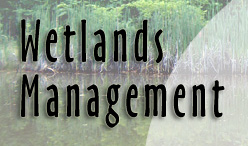|
|
|
|
|
|
Identification, delineation and mitigation |
|
Wetland delineation |
|
Hydrophytic
vegetation |
page 2 of 3 |
|
In order to meet the definition of
hydrophytic or wetland vegetation, the majority (>50%) of the
dominant vegetation species on site must be classified as an
obligate wetland plant, facultative wetland plant, or a facultative
plant (excluding facultative minus). This requires
the ability to identify plants down to species. This can be a
difficult task especially when you try to identify sedges (there are
4,000-5,000 species of sedge in the world!). There are separate lists
developed for each region of the United States. Click
here to view a regional list.
In some circumstances instead of relying strictly on plant species,
some secondary rules can be employed. Some example secondary rules
include the following:
| |
-Two or more dominant
plant species exhibit
morphological adaptations or
have known physiological adaptations for survival in wetlands. (The former must be observed
in most individuals of the dominant species). or
have known physiological adaptations for survival in wetlands. (The former must be observed
in most individuals of the dominant species).
-Visual observations of plants growing in flooded or saturated
soils for at least 10% of the growing season. |
|

